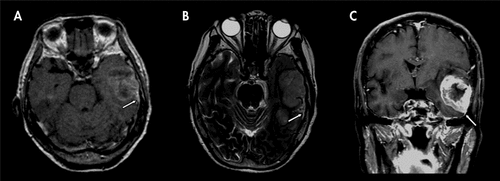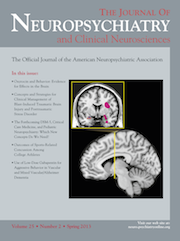Rapidly Progressive Anomic Aphasia: A Rare Presentation of Temporal Lobe Tumor
To the Editor: Brain tumors may demonstrate variable neuropsychiatric symptoms, such as headache, seizure, hemiparesis, and abnormalities of mental status,1 which depend on their neuroanatomic location, and typically have a subacute and progressive course. Herein, we report an elderly patient presenting with rapidly progressive anomic aphasia due to a brain tumor occupying more than three quadrants of the left temporal lobe.
Case Report
An 86-year-old, right-handed woman was hospitalized because of 1 month of difficulties in naming familiar objects and people. The patient presented circumlocution, mentioning the function and the use of the objects. On neurological assessment, the spontaneous speech was fluent, and auditory comprehension and repetitions were intact. Neither motor symptoms nor sensory deficits were detected. The patient could read and write normally. She had no difficulty with a test that required her to perform a sequential set of hand movements. Also, the patient did not have any discomfort about neurological symptoms, memory loss, bizarre behaviors, or delirium symptoms, except anomic aphasia. A laboratory work-up including complete blood cell counts; electrolyte levels; renal, liver, and thyroid function profiles; vitamin B12 and folic acid; serology for syphilis; and human immunodeficiency virus produced normal results. A bran CT and contrast-enhanced MRI revealed a huge solid tumor over the left temporal lobe, causing apparent perifocal edema, compressing the left lateral ventricle, and pushing the midline to the right (Figure 1). She underwent standard tumor resection and radiotherapy. The pathological result revealed a glioblastoma multiforme. However, the anomic aphasia did not improve postoperatively.

Discussion
Anomic aphasia is a special subtype of aphasia characterized by difficulty in naming familiar objects and people. Although aphasia is a common symptom in dementia, anomic aphasia as a core symptom is rarely reported in patients with dementia.2 In the present case, a rapid progression of anomic aphasia without memory impairment excluded the differential diagnosis of Alzheimer's disease. Vascular lesion or other organic problems should be first considered. The CT and MR images revealed that the tumor occupied more than three quadrants of the left temporal lobe (a dominant hemisphere). This result is consistent with studies finding that anomic aphasia almost exclusively occurs with damage to the left hemisphere in right-handed patients.1
Traumatic brain injury, brain surgery, and stroke have been described to be the etiology of secondary anomic aphasia,3,4 which most involved the supramarginal-pulvinar conjunctive area, and was rarely focused in the temporal lobe.4 Furthermore, compared with previous reports of metastatic brain tumor presenting with rapidly progressive dementia,5,6 a solid temporal tumor displaying a rapidly progressive anomic aphasia has never been reported. This report reminds clinicians to be aware that these patients who first display acute anomic aphasia may have more malignant than benign etiology.
Much evidence supports a good outcome of radical resection for either low-grade or high-grade brain tumors.7 However, poor prognostic factors that affecting language deficits, such as old age, female sex, high-grade tumors, and tumors involving two or more quadrants of the temporal lobe, were all present in this patient.7 Consistent with the earlier studies, the anomic aphasia did not improve postoperatively in this patient.
1 : Brain tumors. N Engl J Med 2001; 344:114–123Crossref, Medline, Google Scholar
2 : Neurology of anomia in the semantic variant of primary progressive aphasia. Brain 2009; 132:2553–2565Crossref, Medline, Google Scholar
3 : Pure anomia with spared action naming due to a left temporal lesion. Neuropsychologia 1994; 32:1101–1109Crossref, Medline, Google Scholar
4 : Neuroanatomic correlation of the post-stroke aphasias studied with imaging. Neurol Res 2008; 30:356–360Crossref, Medline, Google Scholar
5 : Lymphomatosis cerebri presenting as rapidly progressive dementia. Neurologist 2007; 13:150–153Crossref, Medline, Google Scholar
6 : Miliary brain metastases presenting as rapidly progressive dementia. Neuropathology 2005; 25:153–158Crossref, Medline, Google Scholar
7 : Cortical localization of temporal lobe language sites in patients with gliomas. Neurosurgery 1994; 34:567–576, discussion 576Crossref, Medline, Google Scholar



